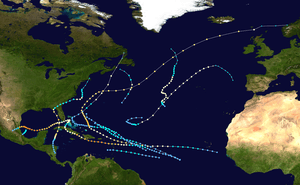Hurricane Faith
Hurricane Faith reached the northernmost latitude and had the longest track of any Atlantic tropical cyclone. The sixth named storm and fifth hurricane of the 1966 Atlantic hurricane season, Faith developed from an area of disturbed weather between Cape Verde and the west coast of Africa on August 21. Tracking westward, the depression gradually intensified and became Tropical Storm Faith on the following day. Moving westward across the Atlantic Ocean, it continued to slowly strengthen, reaching hurricane status early on August 23. About 42 hours later, Faith reached an initial peak with winds of 105 mph (165 km/h), before weakening slightly on August 26. Located near the Lesser Antilles, the outer bands of Faith produced gale force winds in the region, especially Puerto Rico, the Virgin Islands, and Antigua. Minor coastal damage occurred as far south as Trinidad and Tobago.
| Category 3 major hurricane (SSHWS/NWS) | |
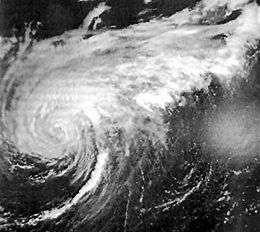 Hurricane Faith on September 1 as it moved towards Cape Hatteras | |
| Formed | August 21, 1966 |
|---|---|
| Dissipated | September 15, 1966 |
| (Extratropical after September 6, 1966) | |
| Highest winds | 1-minute sustained: 125 mph (205 km/h) |
| Lowest pressure | 950 mbar (hPa); 28.05 inHg |
| Fatalities | 4 direct, 1 indirect |
| Areas affected | Lesser Antilles, Bermuda, Faroe Islands, United Kingdom, Ireland, Denmark, Norway, Sweden, Finland, Soviet Union, Arctic |
| Part of the 1966 Atlantic hurricane season | |
By August 28, the storm began to re-intensify, after curving north-northwestward near The Bahamas. At 0000 UTC on the following day, Faith peaked as a 125 mph (205 km/h) Category 3 hurricane Saffir–Simpson hurricane scale. Eventually, the storm weakened back to a Category 2 hurricane and re-curved to the northeast. One person drowned in the western Atlantic after his ship sank. Heavy rainfall and strong winds pelted Bermuda, though no damage occurred. The storm maintained nearly the same intensity as a Category 2 hurricane for several days, while tracking northeastward into the far North Atlantic Ocean. Faith finally weakened while north of Great Britain and became extratropical near the Faroe Islands on September 6. Three other drowning deaths occurred in the North Sea near Denmark. A fifth death occurred after a man succumbed to injuries sustained during a boating incident related to the storm.
Meteorological history
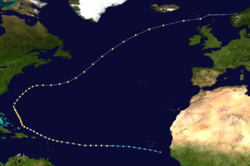
Television Infrared Observation Satellite XI (TIROS XI) imagery indicated the presence of an area of disturbed weather over Ivory Coast on August 18. The system moved slowly westward and eventually reached the Atlantic Ocean.[1] It is estimated that a tropical depression developed at 0000 UTC on August 21, while located about 240 miles (390 km) southeast of Cape Verde.[2] Continuing westward, the depression intensified, and was upgraded to Tropical Storm Faith on the following day. Gradual intensification persisted as Tropical Storm Faith headed nearly due westward at 17 to 23 mph (27 to 37 km/h).[1][2] By August 23, Faith was upgraded to a Category 1 hurricane.[1][2] Curving slightly west-northwestward, the storm reached Category 2 intensity and briefly peaked at sustained winds of 105 mph (165 km/h). Hurricane Faith curved to the northwest and weakened back to a Category 1 hurricane while approaching the northeastern Leeward Islands on August 25.[2] Initially, Faith was scheduled to be seeded as part of Project Stormfury. However, the scheduled seeding was cancelled as Faith was approaching The Bahamas.[3] Bypassing the Leeward Islands, Faith remained at nearly the same intensity, until re-strengthening into Category 2 hurricane on August 28, near Turks and Caicos Islands. The storm quickly intensified further into a Category 3 hurricane only six hours later.[2]
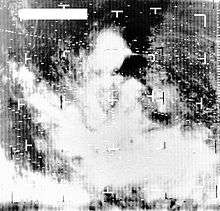
At 00:00 UTC on August 29, Faith attained its maximum sustained winds of 125 mph (205 km/h).[2] After reaching maximum sustained winds late on August 29, Faith began to gradually weaken and decreased to Category 2 hurricane intensity early on August 30.[2] By that time, the storm turned to the northeast around the periphery of an Atlantic subtropical anticyclone while located about midway between Bermuda and Florida.[1][4] Faith remained well offshore of the East Coast of the United States and Atlantic Canada, after veering eastward on September 1.[2] Thereafter, it began to accelerate and eventually curved northeastward.[1] While approaching Europe, Faith's forward speed increased to as much as 50 mph (75 km/h). At 0600 UTC on September 3, a minimum barometric pressure of 950 mbar (28 inHg) was recorded – the lowest in relation to the storm. After remaining a Category 2 hurricane since August 29, Faith weakened slightly to a Category 1 hurricane early on September 6, as it neared the Faroe Islands.[2] Crossing the North Sea, Faith finally transitioned into an extratropical storm at 1200 UTC later that day, while centered about 125 miles (200 km) east-northeast of Tórshavn.[2][1][5] The extratropical remnants of Faith headed eastward and affected Norway with winds as high as 60 mph (95 km/h).[2] Tracking over Scandinavia, the extratropical storm weakened to the equivalent of a tropical depression before entering the Soviet Union (present day Russia). Eventually, the storm degenerated into an extratropical low pressure area, curved northward, and retained its identity until September 15,[6] when it was over Franz Josef Land, which is roughly 600 miles (965 km) from the North Pole.[5]
Impact and records
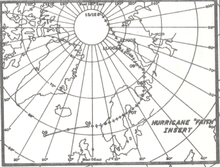
In the Leeward Islands, the approach of Faith caused the tracking station on Antigua – which was monitoring an unmanned rocket launched by the National Aeronautics and Space Administration (NASA) – to shut down 45 minutes after the rocket lifted off.[7] Faith also produced gale force winds across Puerto Rico and the Virgin Islands, though only minor damage and no fatalities or injuries were reported.[5] Further south, Faith brought rough seas to Trinidad and Tobago, with waves ranging from 10 to 15 feet (3.0 to 4.6 m). These conditions inflicted minor damage to small boats and jetties.[8] In the Turks and Caicos Islands, sea defenses suffered some damage as Faith passed about 65 miles (105 km) to the east-northeast.[9] Along the East Coast of the United States, the storm produced rough seas and high tides from Cape Canaveral (then Cape Kennedy), Florida, to the Virginia Capes. Additionally, the Weather Bureau warned of possible gale force winds in The Carolinas and Virginia, but also noted that the area would only experience fringe effects from the storm.[10] In Bermuda, the outer rainbands of Hurricane Faith produced heavy rainfall and wind gusts up to 62 mph (100 km/h).[11]
Five people died as a result of the storm, though only one of them on land.[12][13] Rough seas in the western Atlantic battered the Alberto Benati, pitching one man overboard. Two others drowned near Denmark while attempting to cross the Atlantic Ocean in a rowboat. Another man was missing and presumed dead after heavy seas forced him and his shipmates to abandon their boat off the northern coast of Denmark. Property damage was minimal, mainly because the areas impacted by Faith were sparsely populated.[13] A 2,726 ton Norwegian car ferry known as Skagerak began to sink as it headed for Hirtshals in Region Nordjylland of Denmark. Waves pounded the side hatches, which flooded in the engine room, causing the ship to become disabled. A large-scale search operation was conducted to rescue the 144 passengers aboard. All passengers were rescued and treated for their injuries in Hjørring, Denmark. However, one person later died in the hospital.[12] In Norway, the remnants of Faith impacted areas between Ryfylke and Sunnfjord. The storm brought heavy rainfall and resulted in glacier melting, which in turn caused rampant flooding in some locations. Discharge from the Folgefonna, Fjærland, and Sunnfjord glaciers reached a record high melt due to the remnants of Faith.[14]
Throughout its duration, Faith traveled for 6,850 miles (11,020 km), making it the longest track of an Atlantic hurricane and the second longest worldwide, after Hurricane John in 1994 in the Eastern Pacific Ocean.[15] Faith also traveled to the northernmost latitude of any Atlantic tropical cyclone, reaching as far north as 61.1°N.[16]
See also
- Tropical cyclone effects in Europe
- List of Bermuda hurricanes
- Atlantic hurricane records
References
- Hurricane Faith, August 18 – September 12, 1966 (Preliminary Report) (Report). National Hurricane Center. 1966. p. 1. Retrieved February 14, 2013.
- "Atlantic hurricane best track (HURDAT version 2)" (Database). United States National Hurricane Center. May 25, 2020.
- Ray Popkin (1967). The Environmental Science Services Administration (Report). Environmental Science Services Administration. p. 240. Retrieved February 27, 2013.
- James F. Andrews (November 1966). The Weather and Circulation of August 1966 (PDF). Weather Bureau (Report). National Oceanic and Atmospheric Administration. p. 672. Retrieved February 27, 2013.
- Hurricane Faith, August 18 – September 12, 1966 (Preliminary Report) (Report). National Hurricane Center. 1966. p. 2. Retrieved February 14, 2013.
- Arnold L. Sugg (March 1967). The Hurricane Season of 1966 (PDF) (Report). National Hurricane Center. pp. 137 and 138. Retrieved February 27, 2013.
- More Launches of the Saturn IB (Report). National Aeronautics and Space Administration. Retrieved February 14, 2013.
- C. B. Daniel; R. Maharaj; G. De Souza (May 2001). Tropical Cyclone Affecting Trinidad and Tobago 1725 to 2000 (PDF) (Report). Trinidad and Tobago Meteorological Service. Archived from the original (PDF) on May 23, 2005. Retrieved February 14, 2013.
- Turks and Caicos Islands: Report (Report). H.M. Stationery Office. 1968. p. 38. Retrieved February 27, 2013.
- "Hurricane Faith Losing Its Punch". Sarasota Herald-Tribune. United Press International. September 1, 1966. p. 1. Retrieved February 23, 2013.
- Hurricane history (b) 1963-present that affected Bermuda (Report). Bermuda Climate and Weather. February 6, 2013.
- "Ferry Boat Captain Credits Luck". Edmonton Journal. Associated Press. September 8, 1966. p. 41. Retrieved February 14, 2013.
- Storms of 1966 (Report). Environment Canada. October 12, 1999. Archived from the original on October 7, 2000. Retrieved February 14, 2013.
- Lars Andreas Roald (2008). Rainfall Floods and Weather Patterns (PDF) (Report). Norwegian Water Resources and Energy Directorate. pp. 31 and 34. Archived from the original (PDF) on October 5, 2013. Retrieved February 14, 2013.
- Neal Dorst; Sandy Delgado (May 20, 2011). Subject: E7) What is the farthest a tropical cyclone has traveled? (Report). Atlantic Oceanographic and Meteorological Laboratory. Archived from the original on May 19, 2009. Retrieved February 14, 2013.
- Jeffrey Masters (September 22, 2010). Igor delivers punishing blow to Newfoundland; 95L growing more organized (Report). Weather Underground. Retrieved February 14, 2013.
